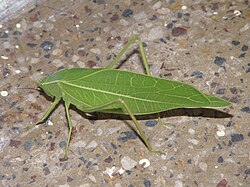Tettigoniidae
The family Tettigoniidae, known in American English as katydids and in British English as bush-crickets, contains more than 6,400 species. It is part of the suborder Ensifera.
| Tettigoniidae | |
|---|---|
| 220px | |
| Great green bush-cricket (Tettigonia viridissima) | |
| Scientific classification | |
| Kingdom: | |
| Phylum: | |
| Class: | |
| Order: | |
| Suborder: | |
| Superfamily: | Tettigonioidea
|
| Family: | Tettigoniidae
|
They are also known as long-horned grasshoppers, though they are more closely related to crickets than to grasshoppers. Their antennae may be longer than their own body length, those of the grasshoppers are always relatively short.
Disguise
Katydids may disguise themselves brilliantly. Some look exactly like dead brown leaves, complete with holes, lying still on the forest floor of the rainforests of Asia and South America. Others act like green, living leaves fluttering from a branch. They even have vein-like markings like real leaves.[1]
+{{{1}}}−{{{2}}}
Tettigoniidae Media
Katydid nymph
Poecilimon thoracicus (Phaneropterinae)
Katydid mimicking a leaf
- Error missing media source
A meadow katydid in Hawaii
Other websites
- Bush katydid genus Scudderia Stål, 1873 - diagnostic photographs, natural history
- Black-sided meadow katydid - Conocephalus nigropleurum - diagnostic photographs
- BugGuide.net--family Tettigoniidae
- Singing Insects of North America (SINA) website. Archived 2009-01-13 at the Wayback Machine
- Bug guide.net-- Pink Katydid
References
| Wikimedia Commons has media related to Lua error in Module:Commons_link at line 62: attempt to index field 'wikibase' (a nil value).. |
| Wikispecies has information on: Tettigoniidae. |
- ↑ Ganeri, Anita (2000). Jungle animals: over 100 questions and answers to things you want to know. Dubai, U.A.E. ISBN 0-75254-909-X.
- ↑ Castner, James L. 1995. Defensive behavior and display of the leaf-mimicking katydid Pterochroza ocellata (Orthoptera: Tettigoniidae: Pseudophyllinae: Pterochrozini). Journal of Orthoptera Research. #4, August.





